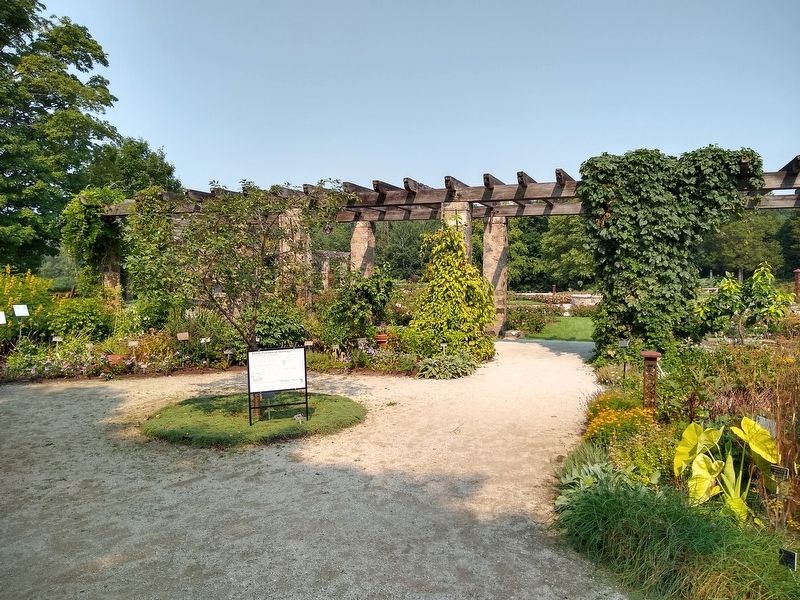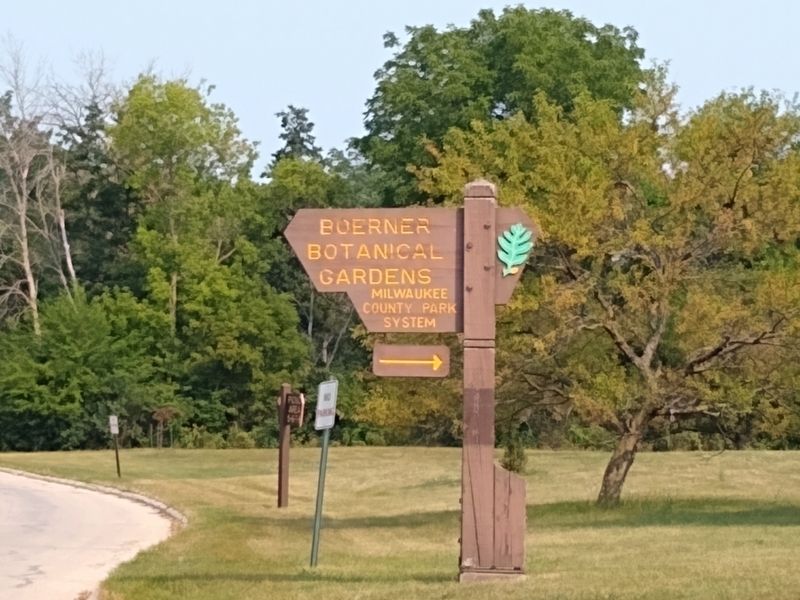Hales Corners in Milwaukee County, Wisconsin — The American Midwest (Great Lakes)
Black Botanical Heritage:
Plants of the African Diaspora
Inscription.
Africa has a rich botanical heritage. So many unique and necessary plants from this continent have made their way around the world from castor beans to watermelons, okra to ancient grains.
Generations of African farmers selected, perfected and domesticated crops that fended off famine, fed their families and were finely tuned to Africa's incredibly diverse growing conditions.
The "culture" of African agriculture was communal, with traditions that respected the land, its limits and carefully balanced the give and take of growing food without depleting the soil. But Africa's people and their agricultural gifts were exploited.
What is the African Diaspora?
During the 400 years of the Trans-Atlantic Slave Trade, more than 12 million Africans were carried off from their homelands and forced to work the mines and plantations of the Americas.
Africa's people were torn from their families and traditions, subjected to crushing workloads and hunger. Today, this tragedy is known as the African Diaspora.
Botanically speaking, this same period is called the "Columbian Exchange" (after Christopher Columbus). Today, we know Columbus's explorations helped spread European culture, education and Christian religion to the New World, but we also realize that, tragically, disease and oppression followed Columbus as well. Coincidentally, many plants from the Old and New Worlds traveled in his wake and took root.
Africans Contributed More Than Just Muscle
African knowledge and agricultural skill fueled Colonial expansion. Africans from the rice-growing regions of West Africa taught South Carolina plantation owners to grow rice. Rice had been domesticated independently in both Africa and Asia for thousands of years. Africans passed on this specialized agricultural knowledge, and rice soon became a profitable plantation crop in the South.
The Traveling Plants
Trade introduced New World crops such as corn and peanuts to Africa. To provide food on voyages, ports sold familiar African food staples like sorghum, African rice and black-eyed peas.
Some Asian plants like bananas and sugarcane also came to the Americas from Africa during this time (these had already spread to Africa by Spice Trade caravans from India and Asia.)
Gardening: A Survival Skill
To survive on meager rations, transplanted Africans had to grow their own food. They tended their own gardens after their workdays were done. Crops of the Americas (corn, peppers, tomatoes, potatoes) were grown with African staples (sorghum, rice, cowpeas and okra), and New World plants like sweet potatoes and tannia.
Heritage
Plants:
As you walk through the Herb Garden, look for plant labels with the Heritage logo. Each tells a story of how these plants connect us to Africa's botanical heritage.
Erected by Boerner Botanical Gardens, Milwaukee County Parks.
Topics. This historical marker is listed in these topic lists: African Americans • Agriculture • Colonial Era.
Location. 42° 56.163′ N, 88° 1.953′ W. Marker is in Hales Corners, Wisconsin, in Milwaukee County. Marker can be reached from the intersection of Whitnall Park Drive and Boerner Drive, on the left when traveling north. Marker is in Boerner Botanical Garden (an entry fee is charged). Touch for map. Marker is at or near this postal address: 9400 Boerner Drive, Hales Corners WI 53130, United States of America. Touch for directions.
Other nearby markers. At least 8 other markers are within walking distance of this marker. John Voight - Boerner Botanical Gardens Director, 1941-1979 (approx. 0.2 miles away); Early 1900s Business District (approx. 0.6 miles away); Hales Corners – A Farm Village (approx. 0.7 miles away); The German Evangelical Church / Brach’s Animal Hospital (approx. 0.7 miles away); Wisconsin's Lime Industry (approx. ¾ mile away); Hales Corners – A Crossroads Community (approx. ¾ mile away); Boyhood Home of Jeremiah Curtin
(approx. 0.8 miles away); St. Mary’s Church and Cemetery (approx. 0.9 miles away). Touch for a list and map of all markers in Hales Corners.
Also see . . . Columbian Exchange. Wikipedia article about the Columbian Exchange, a term coined in 1972 by Alfred W. Crosby. (Submitted on September 29, 2021, by Joel Seewald of Madison Heights, Michigan.)
Credits. This page was last revised on September 29, 2021. It was originally submitted on September 29, 2021, by Joel Seewald of Madison Heights, Michigan. This page has been viewed 181 times since then and 14 times this year. Photos: 1, 2, 3. submitted on September 29, 2021, by Joel Seewald of Madison Heights, Michigan.


